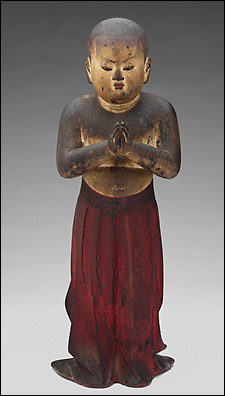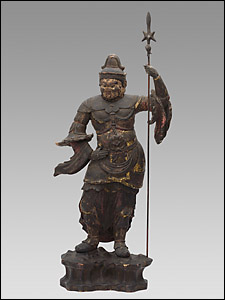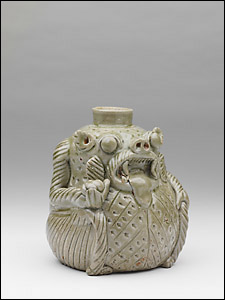HUAM acquires Sedgwick collection
Collection of Chinese ceramics is the most comprehensive of its kind in the West

The Harvard University Art Museums Friday (Oct. 13) announced a major acquisition of Asian works of art through Walter C. Sedgwick and the Walter C. Sedgwick Foundation. Three Japanese Buddhist sculptures and more than 300 early Chinese ceramics, previously on loan to the art museums, will enter the permanent collection of the Arthur M. Sackler Museum’s Department of Asian Art. Exceptional in their beauty, historical significance, and cultural value, the pieces will make a vital contribution to the art museums’ mission of teaching and research. These qualities and the objects’ early dates of creation make these works among the most significant to enter the general holdings of the art museums in many decades.
“A number of experiences have led to my interest in enhancing the Harvard University Art Museums collection of Asian art through the gift of my collection,” said Sedgwick. “Professor John Rosenfield, the noted art historian and a mentor during my undergraduate days at Harvard, had a great influence on me, as well as an enormous impact on the understanding of Asian art in the United States. Equally as rewarding has been my ongoing collaboration with the Harvard University Art Museums and curator Robert Mowry. Bob has been accessible, continually interested and intellectually engaging, and he is the architect and a partner in the building of this collection.”
The three Japanese Buddhist sculptures given by Sedgwick represent one of the most significant such groupings outside of Japan. The pre-eminent work of the three, a magnificent statue of “Prince Shōtoku at Age Two,” portrays the legendary cultural figure Shōtoku Taishi (A.D. 574-622) as a toddler, when he was said to have joined his hands in prayer, chanted the Buddha’s name, and performed the miracle of manifesting a small Buddhist relic. Later, as a political leader, Prince Shōtoku went on to promote and foster the Buddhist faith in Japan. After his death, he was revered as a religious and cultural hero. Of the many three-dimensional representations of Prince Shōtoku – some as a child, some as a youth of 16, and others as a mature statesman – depictions of the prince as an enlightened child are by far the most popular. The Sedgwick statue is the earliest datable and most elegantly crafted of the hundreds of such sculptures in existence.

The Sedgwick gift also includes two important Heian-period (794-1185) Japanese Buddhist wooden sculptures. The earlier of the two is an exquisite mid-11th century “Head of a Bodhisattva,” which appears to have come from one of a series of celestial figures that served as frieze decorations adorning the upper walls of the Byōdō-in, a famous Buddhist temple near Kyoto. This head, from one of the temple’s 50 small-relief bodhisattva sculptures, is believed to be unique among Western museum collections. The second Heian-period image is a statue of “Zōchōten, Guardian King of the South,” originally from a set of four armor-clad deities that stood watch over a Buddhist temple. It was probably carved circa 1075 for a small private aristocratic altar.
“The Harvard University Art Museums have excellent holdings of Japanese woodblock prints and surimono (privately commissioned, luxury-edition prints), just as we have great strength in Japanese lacquer, calligraphy, and certain types of painting. Until now, however, we’ve not had significant holdings in Japanese sculpture,” said Robert D. Mowry, Alan J. Dworsky Curator of Chinese Art and head of the HUAM’s Department of Asian art. “Walter Sedgwick’s generous gift will redress that need, bringing to the art museums three exceedingly important early Japanese Buddhist sculptures that are of – or at least approach – National Treasure quality.”

Over the past decade, the Walter C. Sedgwick Foundation has assembled the finest and most comprehensive collection of early Chinese ceramics in the West, and perhaps anywhere in the world. The foundation has enabled the art museums to acquire the collection through a partial gift/partial purchase arrangement. Comprising more than 300 works that range in date from the Neolithic period (as early as 6000 B.C.) through the Tang dynasty (A.D. 618-907), the collection includes examples of all major ceramic types produced during that nearly 7,000-year period. The Sedgwick Foundation collection illustrates the aesthetic, stylistic, and technical development of early Chinese ceramics and represents major turning points in terms of the medium’s historical development.
“The Sedgwick collections of early Chinese ceramics and Japanese Buddhist sculptures will play an exceptionally important, even transformative, role in the teaching of Asian art here at Harvard,” said Thomas W. Lentz, Elizabeth and John Moors Cabot Director of the Harvard University Art Museums. “The ability of students to study objects through direct observation is the foundation of our teaching mission. These ceramics and sculptures complement the remarkable Asian works in our Grenville L. Winthrop collection, as well as the significant objects amassed more recently by Bob Mowry, thus creating a link to our existing collections and providing an important resource for studying the evolution and history of Asian art. We are deeply grateful to Walter for strengthening our collections with these works.”





